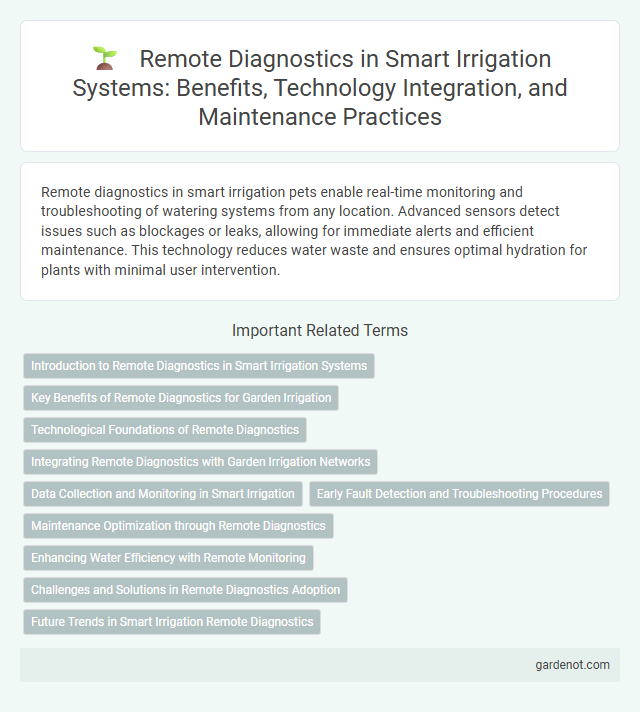Remote diagnostics in smart irrigation pets enable real-time monitoring and troubleshooting of watering systems from any location. Advanced sensors detect issues such as blockages or leaks, allowing for immediate alerts and efficient maintenance. This technology reduces water waste and ensures optimal hydration for plants with minimal user intervention.
Introduction to Remote Diagnostics in Smart Irrigation Systems
Remote diagnostics in smart irrigation systems enable real-time monitoring and troubleshooting of irrigation components through interconnected sensors and cloud-based platforms. This technology leverages IoT devices to assess soil moisture, valve performance, and system leaks remotely, minimizing manual inspections and optimizing water usage. Enhanced data analytics provide actionable insights that reduce downtime and improve irrigation efficiency.
Key Benefits of Remote Diagnostics for Garden Irrigation
Remote diagnostics for garden irrigation enable real-time monitoring and troubleshooting, significantly reducing water wastage and maintenance costs. These systems provide data-driven insights that enhance sprinkler performance and detect issues such as leaks or blockages early. Optimizing irrigation schedules based on sensor data improves plant health and conserves resources efficiently.
Technological Foundations of Remote Diagnostics
Remote diagnostics in smart irrigation leverage Internet of Things (IoT) sensors and wireless communication protocols such as LoRaWAN and NB-IoT to enable real-time monitoring of soil moisture, weather conditions, and irrigation system performance. Advanced data analytics and cloud computing platforms process this data to detect anomalies, predict maintenance needs, and optimize water usage efficiently. Edge computing enhances remote diagnostics by enabling localized data processing, reducing latency, and supporting immediate decision-making for precise irrigation control.
Integrating Remote Diagnostics with Garden Irrigation Networks
Integrating remote diagnostics with garden irrigation networks enables real-time monitoring and automated fault detection, significantly enhancing system efficiency and reducing water waste. Advanced sensors and IoT connectivity provide continuous data on soil moisture, valve performance, and weather conditions, allowing predictive maintenance and timely alerts for troubleshooting. This seamless integration ensures optimal water distribution, promotes sustainable gardening, and minimizes manual intervention.
Data Collection and Monitoring in Smart Irrigation
Remote diagnostics in smart irrigation leverages advanced sensors and IoT technology for continuous data collection on soil moisture, weather conditions, and system performance. Real-time monitoring enables precise irrigation scheduling, reducing water waste and optimizing crop yield. Data analytics provide actionable insights for early detection of system anomalies and targeted maintenance.
Early Fault Detection and Troubleshooting Procedures
Remote diagnostics in smart irrigation enable early fault detection by continuously monitoring system components such as sensors, valves, and controllers for anomalies in real time. Automated alerts prompt swift troubleshooting procedures that identify issues like clogged nozzles, pressure drops, or electrical faults, minimizing water waste and crop stress. Advanced data analytics and IoT integration streamline maintenance workflows, reducing downtime and optimizing irrigation efficiency.
Maintenance Optimization through Remote Diagnostics
Remote diagnostics enables precise monitoring and analysis of irrigation system performance, significantly reducing maintenance costs and downtime. Advanced sensors and IoT connectivity facilitate early detection of leaks, blockages, and equipment malfunctions, ensuring timely interventions. Real-time data analytics optimize irrigation schedules and resource allocation, enhancing overall system efficiency and lifespan.
Enhancing Water Efficiency with Remote Monitoring
Remote diagnostics in smart irrigation systems enable precise real-time monitoring of soil moisture levels, weather conditions, and water usage, significantly increasing water efficiency. Advanced sensors and IoT connectivity allow for immediate detection of leaks, blockages, or equipment malfunctions, minimizing water waste and ensuring optimal irrigation schedules. Implementing remote monitoring technology reduces operational costs and supports sustainable water management by delivering data-driven irrigation adjustments tailored to crop needs.
Challenges and Solutions in Remote Diagnostics Adoption
Remote diagnostics in smart irrigation faces challenges such as connectivity issues, data accuracy, and integration with legacy systems. Solutions include implementing robust IoT networks, utilizing AI-driven analytics for precise fault detection, and adopting standardized communication protocols to ensure seamless interoperability. Overcoming these hurdles enhances predictive maintenance, reduces downtime, and improves water management efficiency.
Future Trends in Smart Irrigation Remote Diagnostics
Emerging technologies in smart irrigation remote diagnostics leverage artificial intelligence and Internet of Things (IoT) sensors to predict system failures and optimize water use efficiency in real-time. Integration of machine learning algorithms enhances fault detection accuracy, enabling proactive maintenance and minimizing downtime. Advanced cloud analytics platforms provide actionable insights and remote monitoring capabilities that drive sustainable agricultural practices and reduce operational costs.
Remote diagnostics Infographic

 gardenot.com
gardenot.com